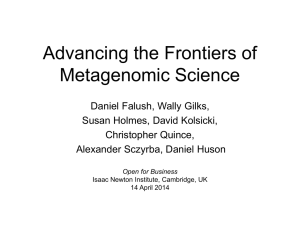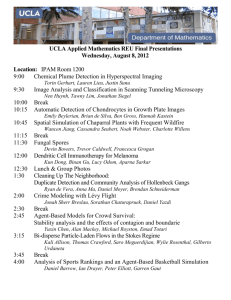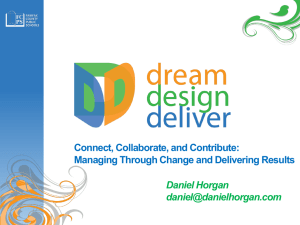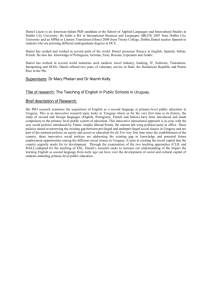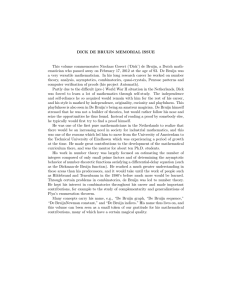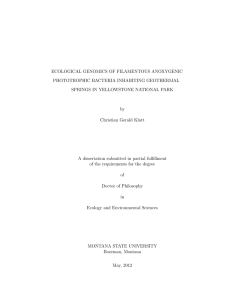HusonGilks - Turing Gateway to Mathematics
advertisement
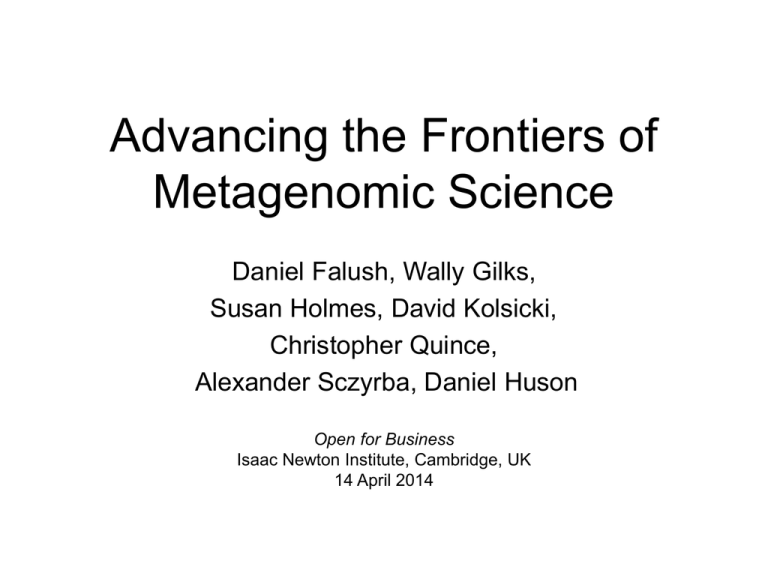
Advancing the Frontiers of Metagenomic Science Daniel Falush, Wally Gilks, Susan Holmes, David Kolsicki, Christopher Quince, Alexander Sczyrba, Daniel Huson Open for Business Isaac Newton Institute, Cambridge, UK 14 April 2014 “Mathematical, Statistical and Computational Aspects of the New Science of Metagenomics” 24 March – 17 April, 2014 Organisers Wally Gilks Daniel Huson Elisa Loza Simon Tavaré Gabriel Valiente Tandy Warnow University of Leeds University of Tübingen National Health Service Blood Transfusion University of Cambridge Technical University of Catalonia University of Illinois at Urbana-Champaign Advisors Vincent Moulton Mihai Pop University of East Anglia University of Maryland Agenda Week 1: Week 2: Week 3: Week 4: Workshop Forming research themes Developing research themes Open for Business Consolidating collaborations Research • • • • • • • Theme Convener Taxonomic profiling Ecological modelling Functional modelling Design and analysis Reference-free analysis CAMI Fourth domain Daniel Falush Christopher Quince Rodrigo Mendes Susan Holmes David Koslicki, Gabriel Valiente Alice McHardy, Alexander Sczyrba Wally Gilks Taxonomic Profiling Presented by Daniel Falush Max-Planck Institute for Evolutionary Anthropology Strain level profiling of metagenomic communities using chromosome painting David Kosliki, Nam Nguyen Daniel Alemany Daniel Falush Strain level variation tells its own story Campylobacter Clonal complexes isolated from a broiler breeder flock over time 100% 90% ST-828 complex 80% ST-692 complex ST-661 complex 70% ST-607 complex 60% ST-574 complex ST-573 complex 50% ST-49 complex ST-45 complex 40% ST-443 complex 30% ST-257 complex ST-21 complex 20% ST-1287 complex ST-1275 complex 10% ST-1150 complex 0% 9 26 Jan 9 23 Feb 8 22 Mar 5 Apr 4 17 May 1 14 28 13 27 Jun Jul 9 23 Aug 6 20 Sep 4 18 Oct 1 15 29 13 Nov Dec 4 17 8 Jan Feb Colles et al, Unpublished Chromosome painting: powerful data reduction and modelling technique from human genetics Chromopainter/FineSTRUCTURE/Globetrotter Painting bacterial genomes based on Kmers of different lengths 10mers 15mers 12mers Our approach • Uses a large fraction of the information in the data • Should work on wide variety of datasets, including 16S and metagenomes. • Should provide strain resolution when the data supports it or classify at species or genus level when it does not. Ecological Modelling Presented by Christopher Quince University of Glasgow Ecological Modelling • Develop ecologically inspired approaches for modelling microbiomics data: – Mixture models (Daniel Falush) – Niche-neutral theory – Communities and phylogeny (Susan Holmes) – Analysis of vaginal microbiome time series data (Stephen Cornell) Stephen Cornell Data from Romera et al. Microbiome (2014) Modelling dynamics of Vaginal Bacterial communities • Simplified description: clustering by community relative abundances – identifies 5 Community State Types (CST) • How do the dynamics differ between 22 pregnant and 32 nonpregnant women? • 143 bacterial species, strong fluctuations Stephen Cornell • • • • • Dynamic model (Markov process) accounts for differences in sampling frequency Underlying dynamics of CST differs between pregnant/non-pregnant Pregnant communities more stable (time constant: 143 days (pregnant) vs. 45 days (non-pregnant)) Pregnant communities much less likely to switch to IV-A (a state correlated with bacterial vaginosis) Transition probability depends on both incumbent and invading CST – Invasion is not just a “lottery” Design and Analysis Presented by Susan Holmes Stanford University Challenges in Statistical Design and Analyses of Metagenomic Data Susan Holmes http://www-stat.stanford.edu/~susan/ Bio-X and Statistics, Stanford Isaac Newton Institute Meeting April,14, 2014 Challenges for the Design of Meta Genomic Data Experiments ▶ Heterogeneity. ▶ Lack of calibration. ▶ Iteration, multiplicity of choices. ▶ Graph or Tree integration. ▶ Reproducibility. ▶ Data Dredging of high throughput data. ▶ Statistical Validation (p-values?). Heterogeneity ▶ ▶ ▶ ▶ Status : response/ explanatory. Hidden (latent)/measured. Different Types : Continuous – ▶ Binary, categorical – ▶ Graphs/ Trees – ▶ Images/Maps/ Spatial Information ▶ Amounts of dependency: independent/time series/spatial. ▶ Different technologies used (454, Illumina, MassSpec, RNA-seq, Images). ▶ Heteroscedasticiy (different numbers of reads, GC context, binding, lab/operator).. Losing information and power Statistical Sufficiency, data transformations. Mixture Models. Documentation and Record Keeping P-values are overrated • Many significant findings today are not reproducible (see JPA Ioannidis - 2005). • Why? • Data dredging? P-values are overrated • Many significant findings today are not reproducible (see JPA Ioannidis - 2005). • Why? • Data dredging? Keeping all the information Normalization Optimality Criteria Chosen at the time of the experiment’s design Optimality Criteria: • Sensitivity or Power: True Positive Rate. • Specificity: True Negative Rate. • Detection of Rare variants • We have to control for many sources of error (blocking, modeling, etc..) • Use of available resources for depth, technical replicates or biological replicates? Conclusions: ▶ ▶ ▶ ▶ Error structure, mixture models, noise decompositions. Power simulations. Data integration phyloseq, use all the data together. Reproducibility: open source standards, publication of source code and data. (R) knitr and RStudio. Needed: Better calibration, conservation of all the relevant information, ie number of reads, variability, quality control results. Reference-free Analysis Presented by David Koslicki Oregon State University Reference-free analysis Zam Iqbal, David Koslicki, Gabriel Valie What can be said about metagenomic samples in the absence of (good) references? Global analysis: How diverse is the sample? How does one sample differ from another? K-mer approach:Can multiple k-mer lengths be used to obtain a multi-scale view of a sample? What is the “right” way to compare k-mer counts across samples? Tools: Complexity function De Bruijn graph (K-mer) Size Matters How diverse is the sample? 14 x 10 7 12 10 8 6 4 2 0 0 20 40 k 60 80 De Bruijn-based metrics How does one sample differ from another? Keep track of how much mass needs to be moved how far. De Bruijn-based metrics AGGA AGAG ACAA ACAG GACA CACA AAAA AAAG CAGA CAGG CAAC AGCA GCAA GCAG ACAC AACA AAGA AGAA AGGG CAAA CAAG GAGG AGAC GGAC GGGG GGGA AAGG GAGA GGAG GAAG GAAA GGAA Connections to de Bruijn Graphs AAAC GAAC AAGC AAAT GAGC ACGA TAGA AGGC GAAT GGCA CCAA CGAA CGAG AGATTAAG TAAA TAGG AACG CCAG CAAT GCAC GACG GGGC CGGA CGAC GGAT AATA ACAT CGGG CACGACCA AAGT ACGG TAAC TACA GAGT ATAG ATAA AGCG AACC CCAC GACC CAGT TGAA AGGT CGCA TGAG TAGC GATA GCATTCAA GCGA GGCG CACC CGGC TCAG TGGA GGGT CATA AGCC TGAC AGTA AATG ACGC GCGG GCCA CGAT TGGG ATGA TAAT TACG AACT ATAC GTAG CCGA CCAT GACT GGCC CCCA GATG GTAA CATG TCAC TGCA AATC ACCG CCGG GCGC GGTA ATGG TGGC TACC AGCT CACT CGCG TAGT AATT GTAC CTAG ATCA CTAA CGGT ATAT TCGA ACCC AGTG GATC TTAA TTAG GGCTACGT TATA CCGC GATT TGAT CATC ACTA TCGG GCCG TCCA CGCC GTGA CATT AGTC TCAT GGTG CTAC GCCC ATGC GTGG AGTT GCGTTGCG GTCA ACCT CCCG CGTA CTGATTAC GTAT TATG GGTC TTGA ATCG TACT CTCA TCGC ATTA GCTA CCCC ACTG TGGT TGCC CGCT CTGG GGTT TTGG ATCC ATGT ACTC TCCG GCCT TGTA TATC GTGC TTCA CCGT CCTA CTAT GTCG CGTG ATTG TCCC ACTT GCTG TATT GTTA GTCC TTGC ATTC TTAT GCTC CCCT CTGC CTCG ATCT GTGT ATTT TCTA CGTC CTTA CGTT CCTG TTCG GCTT TGTG TTTA TGCT CTCC GTTG TGTC TCGT TTCC CCTC CTGT GTCT GTTC CTTG CCTT TTTG TCCT GTTT TCTG TTGT TCTC TGTT TTTC CTCT CTTC CTTT CAGC TTCT TCTT TTTT 14 x 10 7 12 10 8 6 4 2 0 0 20 40 k 60 80 De Bruijn-based metrics Connections to de Bruijn Graphs 14 x 10 7 12 10 8 6 4 2 0 0 20 40 k 60 80 De Bruijn-based metrics Connections to de Bruijn Graphs 14 x 10 7 12 10 8 6 4 2 0 0 20 40 k 60 80 Connection to complexity Connections to de Bruijn Graphs 14 x 10 7 12 10 8 6 4 2 0 0 20 40 k 60 80 De Bruijn-based metrics CAMI: Critical Assessment of Metagenomic Interpretation Presented by Alexander Sczyrba University of Bielefeld CAMI Critical Assessment of Metagenomic Interpretation Organisers: Alice McHardy (U. Düsseldorf), Thomas Rattei (U. Vienna), Alex Sczyrba (U. Bielefeld) Outline • Assessment of computational methods for metagenome analysis • WGS assembly • binning methods • Set of simulated benchmark data sets • generated from unpublished genomes • Decide on set of performance measures • Participants download data und submit assignments via web • Joint publication of results for all tools and data contributors Benchmark data sets • High Complexity, Medium Complexity samples with replicates • Include strain level variations, include species at different taxonomic distances to reference data • Simulate Illumina and PacBio reads from unpublished assembled genomes • Distribute unassembled simulated metagenome samples for assembly and binning Assessment Assembly measures • Reference-dependent measures (NG50, COMPASS, REAPR, Feature Response Curves, etc.) • Reference-independent measures (ALE, LAP, ?) (Taxonomic) binning measures •(macro-) precision and –recall accuracy, •taxonomy-based measures (earth movers distance, i.e. UniFrac, etc.) •bin consistency (taxonomy-aware, or not) Main Goals • comparison of available assemblers and binning tools • best practice for metagenomic assembly and binning • develop a set of guidelines • develop better assembly metrics Contributors • • • • Daniel Huson Richard Leggett Folker Meyer Mihai Pop • • • • Eddy Rubin Monica Santamaria Gabriel Valiente Tandy Warnow • …? Fourth Domain Presented by Wally Gilks University of Leeds Fourth Domain Eukaryota Bacteria Archaea ? Phylogeny of Giant RNA Mimivirus ribosomal genes Boyer M, Madoui M-A, Gimenez G, La Scola B, et al. (2010) Phylogenetic and Phyletic Studies of Informational Genes in Genomes Highlight Existence of a 4th Domain of Life Including Giant Viruses. PLoS ONE 5(12): e15530. doi:10.1371/journal.pone.0015530 http://www.plosone.org/article/info:doi/10.1371/journal.pone.0015530 Questions?
